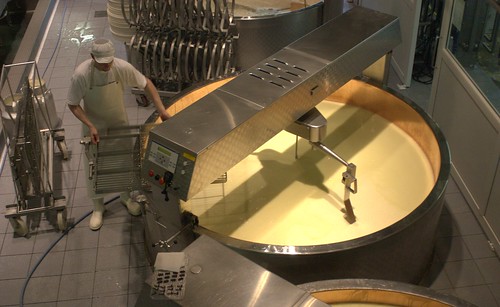Process

Industrial cheese making machinary
Cheese is made from milk from cows, sheep, goats, water buffalo or a mix of those milks.
The fat to protein ratio in the milk is often changed to a standardized level before the milk is processed.
The milk can either be pasteurized, mildly heat treated but not fully pasteurized, or left as raw milk. This makes an impact on the flavor, although if the cheese is made with raw milk, it must be aged for at least 60 days to reduce the possibility of pathogens in the cheese.
A bacteria culture is added to reduce the pH and add flavor. The milk is reduced to a temperature of 90 degrees F - or heated if using raw milk - for 30 minutes to allow the bacteria to grow.
Now the milk gets coagulated. This can be done with an acid, such as acetic acid or gluconodelta-lactone; or with a rennet. The rennet is an enzyme most commonly produced through bioprocessing, but occasionally procured from the stomach of a calf.
The coagulator is added, and let sit for roughly 30 minutes while the milk seperates into curds and whey.
Once the curds reach a certain pH, they're cut down into smaller pieces and heated to assist in removing the whey, and the whey is drained from the vat.
Once the whey is drained, a mat of curds is left. The mat is cut into sections which are stacked on top of each other and turned periodically.
This process is called cheddaring. It drains more of the whey, knits the pieces together, and allows the pH to lower even more, to a range of 5.5 - 5.1.
The cheese is then cut into smaller pieces, and salted. The salting is done differently depending on the type of cheese. For instance, cheddar gets salt mixed in with the curds, while mozzerella gets cut into loaves and submerged in brine.
The cheese is then cut into blocks, and stored in coolers to age for the desired amount of time.
Finally it's cut into its final form, and packaged.